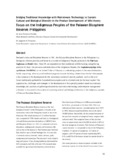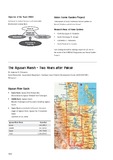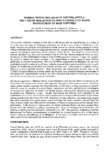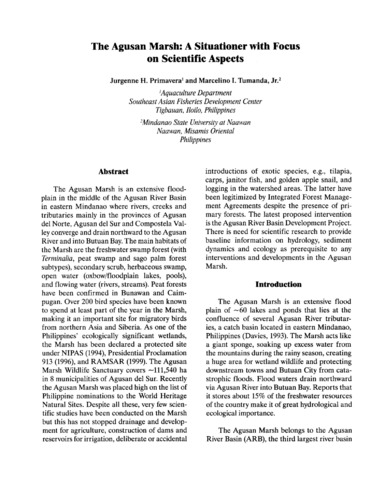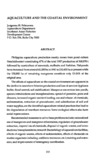Search
Now showing items 1-10 of 26
Bridging traditional knowledge with mainstream technology to sustain cultural and biological diversity in the product development of wild honey: Focus on the indigenous peoples of the Palawan Biosphere Reserve, Philippines
(UNESCO Office, 2008)
Declared a Man and Biosphere Reserve in 1991, the Palawan Biosphere Reserve in the Philippines is a biologically diverse province and home to a number of Indigenous Peoples particularly the Pala’wan, Tagbanua and Batak ...
Series: Summary of Proceedings No. 1/2013
The Agusan Marsh and the Agusan River Basin: The need for science-based development and management
(PCAARRD-DOST, 2013)
The Agusan Marsh - two years after Pakse
(UNESCO Office, 2008)
Using mangroves for aquaculture - Why should we?
(Western Indian Ocean Marine Science Association (WIOMSA), 2011)
Although brackishwater ponds have been a major factor in mangrove loss in Southeast Asia where aquaculture is centuries-old, the “No Touch option” for mangroves is a luxury that most countries in the region cannot afford. ...
A primer on putian.
(Fishfarmers Technical Assistance Foundation, Inc, 1986)
With the growing interest among fishfarmars in the culture of sugpo or Penaeus monodon, some attention is being focused on the lesser known prawns and shrimps such as putian, Hipong puti (Tagalog), putian (Cebuano, Ilongo), ...
Mangrove conversion and brackishwater pond culture in the Philippines
(Asian Wetland Bureau; Protected Areas and Wildlife Bureau, 1992)
Around 50% of mangrove loss in the Philippines can be traced to brackishwater pond construction. The decrease in mangroves from 450 000 ha in 1920 to 132 500 ha in 1990 has been accompanied by expansion of culture ponds ...
Development of broodstock for small-scale shrimp hatchery (with particular reference to Penaeus monodon)
(South China Sea Fisheries Development and Coordinating Programme, 1982)
To be self-sufficient in spawner/larval supply, a small-scale Penaeus monodon hatchery should have the following: 1) broodstock tanks or pens depending on location and other factors; 2) pond sources of broodstock of ...
Marine protected areas in the Philippines: The case of Malalison island in community-based management of reef fisheries
(UNESCO Office, 2004)
The extensive Philippine coastline of more than 22,540 k m provides the natural habitat of a variety of flora and fauna that make the Philippine archipelago one of the centers of marine biodiversity in the world. Resource-use ...
The Agusan marsh: A situationer with focus on scientific aspects
(UNESCO Jakarta Office, Philippine Council for Aquatic and Marine Research and Development, 2008)
The Agusan Marsh is an extensive floodplain in the middle of the Agusan River Basin in eastern Mindanao where rivers, creeks and tributaries mainly in the provinces of Agusan del Norte, Agusan del Sur and Compostela Valley ...
Series: PCAMRD Book Series; No. 10/1991
Aquaculture and the coastal environment
(Philippine Council for Aquatic and Marine Research and Development, 1991)
Philippine aquaculture production mostly comes from pond culture (brackishwater) constituting 47% of the total 1987 production of 560,970 t followed by mariculture of seaweeds, mollusks and finfishes. Fishponds have increased ...

